What do you know about different types of rice and their benefits?
August 19, 2022
Factory Offers
Rice is an indispensable food in the tray of Asian people. But do you know how many types of rice there are and their different uses? Some types are good for health, while others are not beneficial if eaten in large quantities.
Let’s learn about some of the main types of rice and their nutritional benefits below
Brown rice

Brown rice is very popular nowadays. Unlike white rice, brown rice is lightly processed, without the bran and with the germ removed. This makes brown rice more nutritious than white rice. It contains beneficial nutrients like quercetin, luteolin and apigenin.
These nutrients may reduce the risk of degenerative diseases, like heart disease and some cancers. In addition, brown rice contains 3 times more fiber and more protein than white rice. It makes you feel full for longer, and is good for digestion. Brown rice is rich in magnesium and can help prevent blood sugar spikes, making it safe and beneficial for people with diabetes.
White rice

White rice is rice that has had its bran and germ removed during processing. It is also the most popular type of rice because the processing extends the shelf life of the rice, but also strips it of many of its nutrients.
The end product is not only low in nutrition, but also low in fiber, minerals, vitamins, protein and antioxidants. That is why white rice is not safe for people with diabetes. Eating too much white rice is also not good for your health.
Violet glutinous rice

In ancient China, jasmine rice was a delicacy reserved only for the royal family, so it was also known as Forbidden Rice. When cooking, the black color of the rice gradually turns to deep purple. There are many varieties of brown rice, all of which are rich in antioxidants.
This means that brown rice helps fight the effects of oxidative stress and may prevent the progression of age-related degenerative diseases, heart problems, cognitive decline and diabetes. type 2 road.
In addition, brown rice is rich in anthocyanins, flavonoid plant pigments associated with a range of anti-inflammatory and anti-cancer properties.
Red rice

Dragon blood rice, also known as red rice, is a variety of rice that is often grown in deep flooded areas. They carry in themselves quite intense vitality that can adapt to all conditions to live.
Dragon blood rice has a grain, which is red-brown when broken in half, and the inside is still red. Rice when cooked into rice is very fragrant and greasy, dragon blood rice when eaten has a fleshy taste, the more it tastes sweet and fatty.
Dragon blood rice contains starch, protein, fat, fiber, acids, vitamins B1, B2, B5, B6, … and acids such as paraaminobenzoic (PABA), folic (vitamin M), phytic and trace elements: calcium, iron, magnesium, selenium, glutathione (GSH), potassium, sodium.
Red rice helps prevent heart disease, prevent cancer, prevent asthma, fight osteoporosis, create a feeling of fullness for a long time, thereby helping to lose weight,…especially having the ability to eliminate toxins in the body. .
Red rice comes in many colors, from dark brown to brick. It combines the benefits of brown rice such as antioxidant flavonoid, rich in protein and fiber. Studies show that red rice is better than brown rice in fighting free radicals and preventing oxidative stress. However, like most whole grains, red rice is more expensive than white rice and takes longer to cook. However, to save money, you can mix red or brown rice with brown or white rice. This way is both more economical and ensures a healthier diet.
Marina Nguyen
https://factory-offers.com/top-8-best-rice-types-in-the-world/
